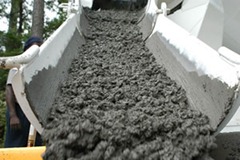
Factors that affects the concrete mix design strengths are:
Variables in Mix Design
- A. Water/cement ratio
- B. Cement content
- C. Relative proportion of fine & coarse aggregates
- D. Use of admixtures
factors affecting concrete mix design strength
 A. Water/cement ratio
A. Water/cement ratio
Water to cement ratio (W/C ratio) is the single most important factor governing the strength and durability of concrete. Strength of concrete depends upon W/C ratio rather than the cement content. Abram’s law states that higher the water/cement ratio, lower is the strength of concrete. As a thumb rule every 1% increase in quantity of water added, reduces the strength of concrete by 5%. A water/cement ratio of only 0.38 is required for complete hydration of cement. (Although this is the theoretical limit, water cement ratio lower than 0.38 will also increase the strength, since all the cement that is added, does not hydrate) Water added for workability over and above this water/cement ratio of 0.38, evaporates leaving cavities in the concrete. These cavities are in the form of thin capillaries. They reduce the strength and durability of concrete. Hence, it is very important to control the water/cement ratio on site. Every extra liter of water will approx. reduce the strength of concrete by 2 to 3 N/mm2 and increase the workability by 25 mm. As stated earlier, the water/cement ratio strongly influences the permeability of concrete and durability of concrete. Revised IS 456-2000 has restricted the maximum water/cement ratios for durability considerations by clause 8.2.4.1, table 5.
B. Cement content
Cement is the core material in concrete, which acts as a binding agent and imparts strength to the concrete. From durability considerations cement content should not be reduced below 300Kg/m3 for RCC. IS 456 –2000 recommends higher cement contents for more severe conditions of exposure of weathering agents to the concrete. It is not necessary that higher cement content would result in higher strength. In fact latest findings show that for the same water/cement ratio, a leaner mix will give better strength. However, this does not mean that we can achieve higher grades of concrete by just lowering the water/cement ratio. This is because lower water/cement ratios will mean lower water contents and result in lower workability. In fact for achieving a given workability, a certain quantity of water will be required. If lower water/cement ratio is to be achieved without disturbing the workability,cement content will have to be increased. Higher cement content helps us in getting the desired workability at a lower water/cement ratio. In most of the mix design methods, the water contents to achieve different workability levels are given in form of empirical relations.
Water/cement ratios required to achieve target mean strengths are interpolated from graphs given in IS 10262 Clause 3.1 and 3.2 fig 2. The cement content is found as follows: –
Thus, we see that higher the workability of concrete, greater is cement content required and vice versa. Also, greater the water/cement ratio, lower is the cement content required and vice versa.
C. Relative proportion of fine, coarse aggregates gradation of aggregates.
Aggregates are of two types as below:
a. Coarse aggregate (Metal): These are particles retained on standard IS 4.75mm sieve.
b. Fine aggregate(Sand): These are particles passing standard IS 4.75mm sieve.
Proportion of fine aggregates to coarse aggregate depends on following:
i. Fineness of sand: Generally, when the sand is fine, smaller proportion of it is enough to get a cohesive mix; while coarser the sand, greater has to be its proportion with respect to coarse aggregate.
ii. Size& shape of coarse aggregates: Greater the size of coarse aggregate lesser is the surface area and lesser is the proportion of fine aggregate required and vice versa. Flaky aggregates have more surface area and require greater proportion of fine aggregates to get cohesive mix. Similarly, rounded aggregate have lesser surface area and require lesser proportion of fine aggregate to get a cohesive mix.
iii. Cement content: Leaner mixes require more proportion of fine aggregates than richer mixes. This is because cement particles also contribute to the fines in concrete.




